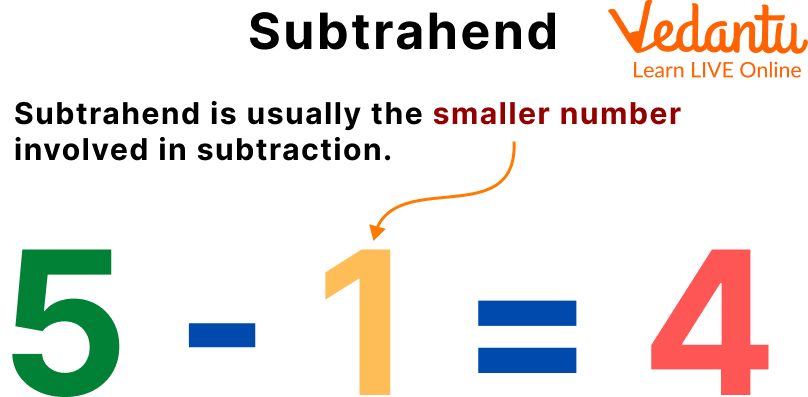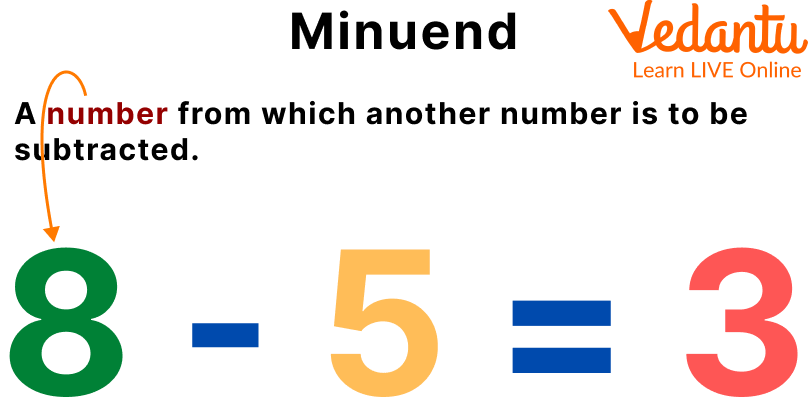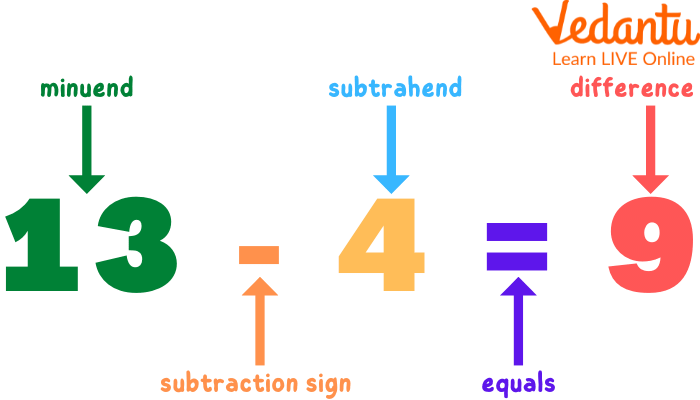




How to Identify Subtrahend and Minuend in Subtraction Problems
Subtraction is the process of taking one number away from another. The numbers involved in subtraction have specific, fancy-sounding names to make the whole process much simpler. In this article, we’re learning the basics of these various names and understanding them better to ace subtraction in various forms. We are going to be dealing with minute subtrahend differences. Let’s dive right in.

Subtrahend, Minuend, and Difference
What is Subtrahend?
Before you panic hearing this complex word, you already know these concepts by different names.
Subtrahend is usually the smaller number involved in subtraction. You might know this number as the ‘subtract’ number as you may have referred to it like that in lower classes.
Given below is a Subtrahend example
“Subtract 4 from 20”
4 is the Subtrahend or the ‘subtract’ number (called so as the word “subtract” is present before the number.)
For example, $3002 - 2000 = 1002$
Here, 2000 is the smaller number and hence the subtrahend in the given case

Subtrahend
What is Minuend?
The minuend is usually the bigger number involved in subtraction. You might know this number as the ‘from’ number as you may have referred to it like that in lower classes.
Given below is a minuend example
“Subtract 4 from 20”
20 is the Minuend or the ‘from’ number (called so as the word “from” is present before the number.)
For example, $3000 - 2000 = 1000$
Here, 3000 is the bigger number and hence the minuend in the given case.

Minuend
What is the Difference?
The answer of subtraction also has a fancy name, known as the difference.
What you obtain by subtracting the Subtrahend from the Minuend is called the Difference (It is kind of a mouthful but you will get a hang of it)
If you know what a sum is, the difference is pretty equivalent to that. To make it easier to understand, the difference can often be compared to the distance between any two given numbers (minuend and subtrahend).
For example, $3000 - 2000 = 1000$
Here, 1000 is the difference between the two numbers and hence the difference in the given case.

Difference
Solved Examples
Q1. Identify the Subtrahend, minuend, and difference in the following problem $200 - 40 =160$
Ans:
200 is the Minuend as it is the larger number
40 is the subtrahend as it is the smaller number
160 is found to be the difference
Q2. Write the equation for the following statement and identify the subtrahend, minuend, and difference.
“From 400 subtract 250”
Ans: The above statement can be written as follows: $400 - 250 = 150$
Here, 400 is the minuend
250 is the subtrahend
150 is found to be the difference
Q3. Identify the Subtrahend, minuend, and difference in the following problem $500 - 50 = 450$
Ans:
500 is the Minuend as it is the larger number
50 is the subtrahend as it is the smaller number
450 is found to be the difference
Q4. Write the equation for the following statement and identify the subtrahend, minuend, and difference. “From 750 subtract 100”
Ans: The above statement can be written as follows: $750 - 100 = 650$
Here, 750 is the minuend
100 is the subtrahend
650 is found to be the difference
Q5. Write the equation for the following statement and identify the subtrahend, minuend, and difference. “From 2000 subtract 500”
Ans: The above statement can be written as follows: $2000 - 500 = 1500$
Here, 2000 is the minuend
500 is the subtrahend
1500 is found to be the difference
Practice Problems
Q1. Identify the subtrahend, minuend, and difference from the following, $300 - 30 = 270$
Ans: 300-Minuend, 30-Subtrahend, 270-Difference
Q2. Identify the subtrahend, minuend, and difference from the following, $500 - 80 = 420$
Ans: 500-Minuend, 80-Subtrahend, 420-Difference
Q3. Arrange the given digits as minuend and subtrahends and give the difference: 4000, 200
Ans: $4000 - 200 = 3800$, 3800-difference
Q4. Subtract 500 from 2500 and identify the parts of a subtraction
Ans: 2500-Minuend, 500-Subtrahend. Difference- 2000
Q5. Subtract 200 from 1000 and identify the parts of a subtraction
Ans: 1000-Minuend, 200-Subtrahend. Difference- 800
Summary
To quickly brush through what we have learned, Minuend is the bigger number of subtraction, also called the ‘from’ number. It usually is the first number in a subtraction problem. Subtrahend is the smaller number of subtraction, also called the ‘subtract’ number. It usually is the second number in a subtraction problem. The difference is the answer to the subtraction problem. It is also referred to as the distance between the given two numbers (minuend and subtrahend).
FAQs on Subtrahend and Minuend Explained with Examples
1. What is a minuend and a subtrahend?
Minuend and subtrahend are essential terms in subtraction. The minuend is the number from which you subtract, while the subtrahend is the number being subtracted. For example, in $8 - 3 = 5$, 8 is the minuend and 3 is the subtrahend.
2. What are the three parts of subtraction?
In a subtraction problem, there are three main parts:
- Minuend: The number you start with
- Subtrahend: The number you subtract
- Difference: The result For example, in $10 - 4 = 6$, 10 is the minuend, 4 is the subtrahend, and 6 is the difference.
3. What is the minuend called?
The minuend, in every subtraction sentence, is the first number or the starting number. It is the quantity from which another number (the subtrahend) is taken away, leading to the final answer called the difference.
4. How to know the subtrahend?
To identify the subtrahend in a subtraction equation, look for the number written after the minus sign ($-$). This value is being subtracted from the minuend. For example, in $9 - 6 = 3$, 6 is the subtrahend.
5. Why is the subtrahend important in subtraction?
The subtrahend is crucial because it determines how much is taken away from the minuend. Without the subtrahend, you cannot perform subtraction or find the correct difference, which is a fundamental step in any calculation involving subtraction.
6. Can the subtrahend be larger than the minuend?
In basic arithmetic, the subtrahend is usually smaller than the minuend for a positive answer. However, if the subtrahend is larger, the difference becomes negative. For example, $5 - 8 = -3$, where 8 is the subtrahend and the result is negative.
7. Is the minuend always written first in subtraction?
Yes, in every subtraction problem, the minuend is always the first number. This order helps clarify that you are subtracting the subtrahend from the minuend to calculate the difference. For example, in $12 - 7 = 5$, 12 is the minuend.
8. Are minuend and subtrahend used in everyday math?
Minuend and subtrahend are terms that describe the numbers involved in subtraction. While the words may not be used every day, understanding their meaning helps with learning math concepts and solving subtraction problems accurately and confidently.

















